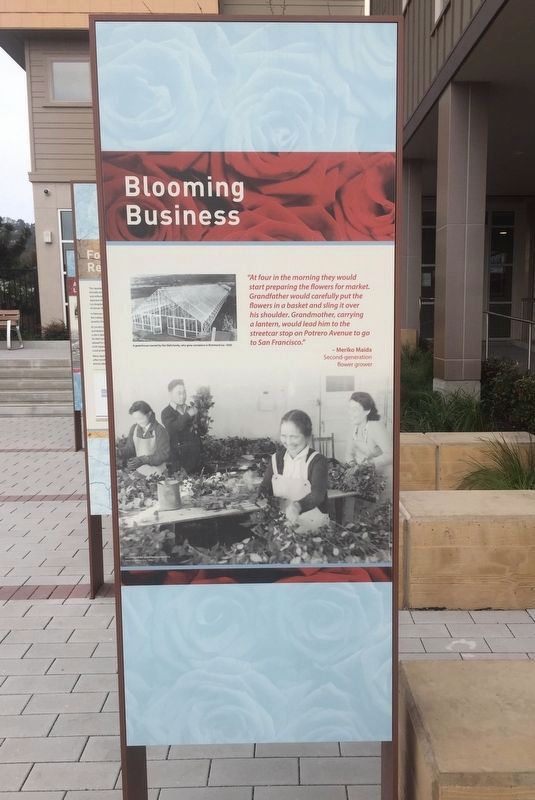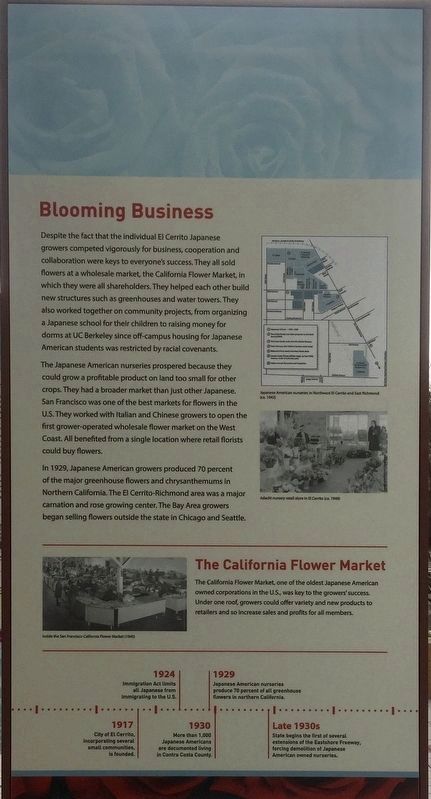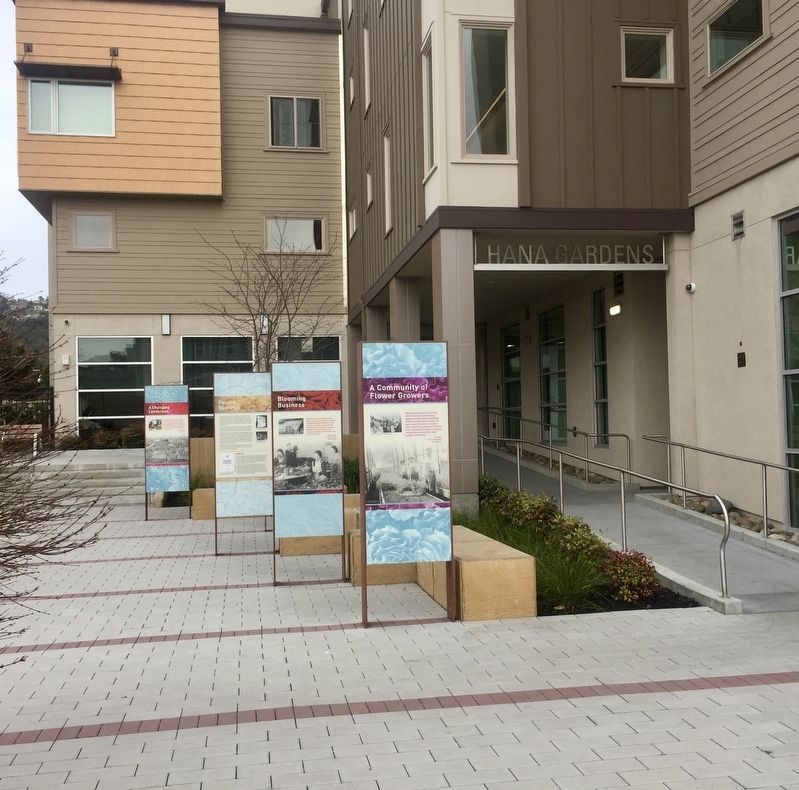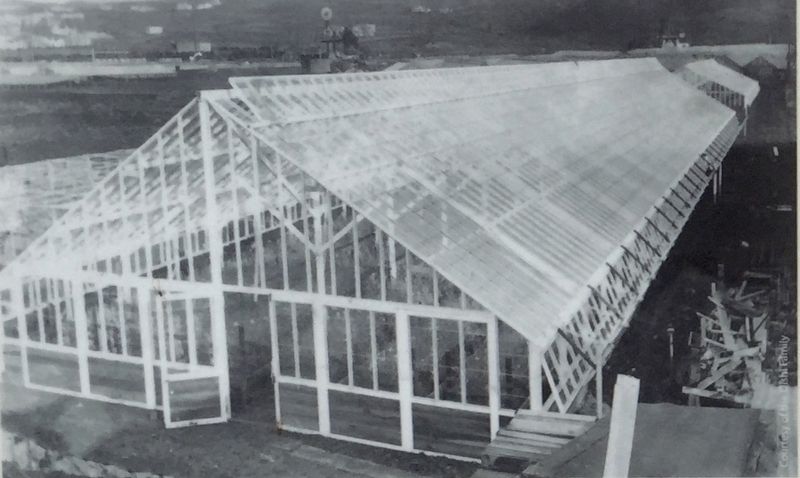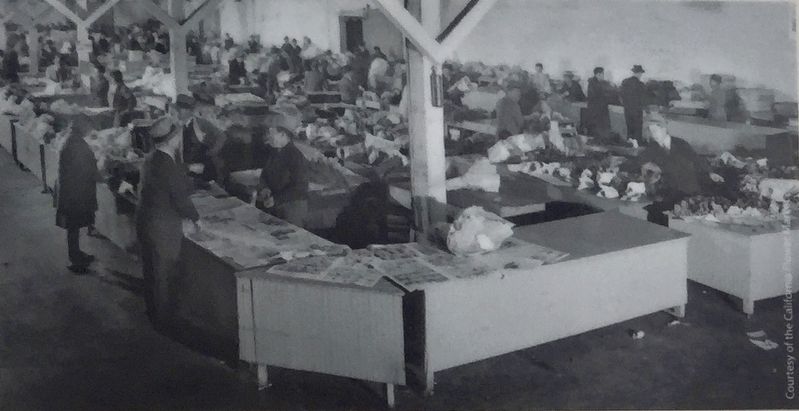Blooming Business
"At four in the morning they would start preparing the flowers for market. Grandfather would carefully put the flowers in a basket and sling it over his shoulder. Grandmother, carrying a lantern, would lead him to the streetcar stop on Potrero Avenue to go to San Francisco."
- Meriko Maida
Second-generation flower grower
(other side)
Despite the fact that the individual El Cerrito Japanese growers competed vigorously for business, cooperation and collaboration were keys to everyone's success. They all sold flowers at a wholesale market, the California Flower Market, in which they were all shareholders. They helped each other build new structures such as greenhouses and water towers. They also worked together on community projects, from organizing a Japanese school for their children to raising money for dorms at UC Berkeley since off-campus housing for Japanese American students was restricted by racial covenants.
The Japanese American nurseries prospered because they could grow a profitable product on land too small for other crops. They had a broader market than just other Japanese. San Francisco was one of the best markets for flowers in the U.S. They worked with Italian and Chinese growers to open the first grower-operated wholesale flower
market on the West Coast. All benefited from a single location where retail florists could buy flowers.In 1929, Japanese American growers produced 70 percent of the major greenhouse flowers and chrysanthemums in Northern California. The El Cerrito-Richmond area was a major carnation and rose growing center. The Bay Area growers began selling flowers outside the state in Chicago and Seattle.
The California Flower Market
The California Flower Market, one of the oldest Japanese American
owned corporations in the U.S., was key to the growers' success.
Under one roof, growers could offer variety and new products to
retailers and so increase sales and profits for all members.
(timeline:)
1917 City of El Cerrito, incorporating several small communities, is founded.
1924 Immigration Act limits all Japanese from immigrating to the U.S.
1929 Japanese American nurseries produce 70 percent of all greenhouse
flowers in northern California.
1930 More than 1,000 Japanese Americans are documented living in Contra Costa County.
Late 1930s State begins the first of several extensions of the Eastshore Freeway, forcing demolition of Japanese American owned nurseries.
Topics. This historical marker is listed in these topic lists: Agriculture
Location. 37° 54.923′ N, 122° 18.657′ W. Marker is in El Cerrito, California, in Contra Costa County. Marker is on San Pablo Avenue, on the right when traveling north. Touch for map. Marker is at or near this postal address: 10860 San Pablo Avenue, El Cerrito CA 94530, United States of America. Touch for directions.
Other nearby markers. At least 8 other markers are within walking distance of this marker. Forced Removal (a few steps from this marker); A Community of Flower Growers (a few steps from this marker); The Japanese in El Cerrito, a Timeline (within shouting distance of this marker); Contra Costa Florist (within shouting distance of this marker); City Hall (within shouting distance of this marker); Corridors of Change (within shouting distance of this marker); The Industrial Core (approx. ¼ mile away); Quarries (approx. ¼ mile away). Touch for a list and map of all markers in El Cerrito.
Credits. This page was last revised on September 16, 2020. It was originally submitted on September 15, 2020, by Andrew Ruppenstein of Lamorinda, California. This page has been viewed 171 times since then and 16 times this year. Photos: 1, 2, 3, 4, 5. submitted on September 16, 2020, by Andrew Ruppenstein of Lamorinda, California.
